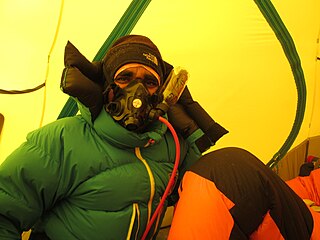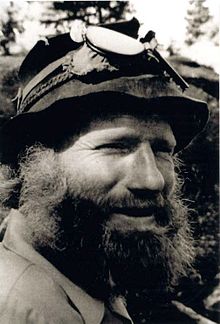
Nanda Devi is the second-highest mountain in India, after Kangchenjunga, and the highest located entirely within the country. Nanda Devi is the 23rd-highest peak in the world.

Eric Earle Shipton, CBE, was an English Himalayan mountaineer.
Thomas Frederic Hornbein was an American mountaineer and anesthesiologist who made the first ascent of Mount Everest via the west ridge; the Hornbein Couloir on Everest was named in his honor. On top of his mountaineering achievements, Hornbein was a professor of anesthesiology and physiology at the University of Washington.

Nawang Gombu was a Sherpa mountaineer who was the first man in the world to have climbed Mount Everest twice.

Louis French Reichardt is a noted American neuroscientist and mountaineer, the first American to summit both Everest and K2. He was also director of the Simons Foundation Autism Research Initiative, the largest non-federal supporter of scientific research into autism spectrum disorders and is an emeritus professor of physiology and biochemistry/biophysics at UCSF, where he studied neuroscience. The character of Harold Jameson, U.C.S.F. biophysicist and mountaineer in the film K2, is based on Reichardt, though the events of his actual 1978 K2 attempt with Jim Wickwire bear little resemblance to the plot of the film.

Hubert Adams "Ad" Carter was an American mountaineer, language teacher and was editor of the American Alpine Journal for 35 years.

Harish Chandra Singh Rawat was a mountaineer who climbed the Mt. Everest in 1965. He was one of the 9 summiters of the first successful Indian Everest Expeditions that climbed Mount Everest in May 1965 led by Captain M S Kohli. He is the 7th Indian man and 22nd man in world that climbed Mount Everest. On May 24, 1965 Vohra and Ang Kami Sherpa together reached the top of Mount Everest On May 29, 12 years to the day from the first ascent of Mount Everest the fourth and last summit team with Major H. P. S. Ahluwalia and Phu Dorjee Sherpa, Rawat reached on the summit. This was the first time three climbers stood on the summit together.
Barry Chapman Bishop was an American mountaineer, scientist, photographer and scholar. With teammates Jim Whittaker, Lute Jerstad, Willi Unsoeld and Tom Hornbein, he was a member of the American Mount Everest Expedition led by Norman Dyhrenfurth, the first American team to summit Mount Everest on May 22, 1963. He reached the summit of Mount Everest by the South Col route on May 22, 1963 with fellow American Lute Jerstad, sharing the honor of becoming the second and third Americans to stand on Everest's summit. Prior to his Everest summit, Bishop participated in several other notable first ascents; the West Butress route on Denali in 1951, and the South West ridge route on 6,170 meter Himalayan peak Ama Dablam in 1961. He worked for the National Geographic Society for most of his life, beginning as a picture editor in 1959 and serving as a photographer, writer, and scientist with the society until his retirement in 1994. He was killed in an automobile accident near Pocatello, Idaho later that year.

Expedition climbing, is a type of mountaineering that uses a series of well-stocked camps on the mountain leading to the summit, that are supplied by teams of mountain porters. In addition, expedition climbing can also employ multiple 'climbing teams' to work on the climbing route—not all of whom are expected to make the summit—and allows the use of supports such as fixed ropes, aluminum ladders, supplementary oxygen, and sherpa climbers. By its nature, expedition climbing often requires weeks to complete a given climbing route, and months of pre-planning given the greater scale of people and equipment that need to be coordinated for the climb.

Luther Gerald "Lute" Jerstad was an American mountaineer and mountain guide who was a member of the 1963 American Mount Everest expedition. He reached the summit of Mount Everest by the South Col route on May 22, 1963 with Barry Bishop. Three weeks earlier, on May 1, Jim Whittaker and Indian mountaineer Nawang Gombu, who was of Sherpa origin, had reached the summit, placing an American flag there. Jerstad and Bishop were the second and third Americans to summit Mount Everest. Jerstad described seeing the flag as he and Bishop approached the summit, "Just then we came over the last rise and there was that American flag -- and what a fantastic sight! That great big flag whipping in the breeze, and the ends were tattered."

The Hornbein Couloir is a narrow and steep couloir high to the west on the north face of Mount Everest in Tibet, that extends from about 8,000 to 8,500 m elevation, 350 metres below the summit.

Norman Gunther Dyhrenfurth was a German-Swiss-American mountaineer and filmmaker. He was the leader of the successful American Mount Everest Expedition of 1963, which placed six climbers on the summit.

The Lho La(Chinese: 洛拉山坳) is a col on the border between Nepal and Tibet north of the Western Cwm, near Mount Everest. It is at the lowest point of the West Ridge of the mountain at a height of 6,006 metres (19,705 ft). It is not exactly a Pass, but a part of Mt. Everest Range

Ang Tharkay was a Nepalese mountain climber and explorer who acted as sherpa and later sirdar for many Himalayan expeditions. He was "beyond question the outstanding sherpa of his era" and he introduced Tenzing Norgay to the world of mountaineering.
Andrew David "Andy" Tyson was an American businessman, writer, and mountaineer. Tyson was known for his first ascents of Gamlang Razi and for climbing new routes on China's Genyen Massif. Over the course of Tyson's mountaineering career, he would go on to climb some of the world's most notable peaks, including Everest, Cho Oyu, Nanda Devi, Denali, Aconcagua in Argentina; the Vinson Massif in Antarctica; and Mount Blanc in the Alps.
The role of The Doon School in Indian mountaineering describes the formative links between The Doon School, an all-boys boarding school in Dehradun, India, and early, post-Independence Indian mountaineering. From the 1940s onwards, Doon's masters and students like A.E. Foot, R.L. Holdsworth, J.A.K. Martyn, Gurdial Singh, Jack Gibson, Aamir Ali, Hari Dang, Nandu Jayal, were among the first to go on major Himalayan expeditions in a newly independent nation. These early expeditions contributed towards laying the foundation of mountaineering in an independent India. Mountaineer and chronicler Harish Kapadia wrote in his book Across Peaks & Passes in Garhwal Himalaya: "To my mind, it was when Gurdial Singh [then a Doon School master] climbed Trisul in 1951 that was the beginning of the age of mountaineering for Indians."

The 1979 Yugoslav Mount Everest expedition was the first successful summit of Mount Everest (8,848m) using the entire West Ridge route in the North Face of Everest. It was the seventh expedition in the Himalayas by the Yugoslav alpinist team, and their first ascent to the highest peak of Mount Everest. The route became known as the "Yugoslavian route" after the first successful ascent. The Yugoslav state leadership declared this ascent the greatest achievement of Yugoslav sports up to that time.

On the 1963 American Mount Everest expedition, Jim Whittaker and Sherpa Nawang Gombu reached the summit of Mount Everest on May 1, 1963, using the conventional route via the South Col. This was the first time the summit had been reached by an American. However, on May 22 two other team members also reached the summit, this time taking a route that traversed the mountain by ascending the West Ridge and moving onto the North Face to attain the summit before descending via the South Col. To traverse a mountain is to go up one side of the mountain and down another and Everest had never been traversed before.
















